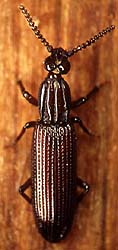
Omoglymmius is a genus of wrinkled bark beetles in the subfamily Rhysodinae, found on every continent except Africa and Antarctica. There are at least 150 species in Omoglymmius.
Omoglymmius bicarinatus is a species of beetle in the subfamily Rhysodidae. It was described by R.T. & J.R. Bell in 1982.
Omoglymmius crassicornis is a species of beetle in the subfamily Rhysodidae. It was described by R.T. & J.R. Bell in 1982.
Omoglymmius cupedoides is a species of beetle in the subfamily Rhysodinae. It was described by R.T. Bell & J.R. Bell in 1993. It is known from Madang, Papua New Guinea, where it was collected in 1896.
Omoglymmius ferrugatus is a species of beetle in the subfamily Rhysodinae. It was described by R.T. Bell & J.R. Bell in 1988. It is known from Potil Kecil in Banggai Archipelago, east of Sulawesi (Indonesia).
Omoglymmius gressitti is a species of beetle in the subfamily Rhysodidae. It was described by R.T. Bell and J.R. Bell in 1985. It is known from Mount Missim near Wau, Papua New Guinea. It is named for J. L. Gressitt and his wife, Margaret, "for their kind hospitality and assistance on our field trip to the Wau Ecological Institute".
Omoglymmius iridescens is a species of beetle in the subfamily Rhysodidae. It was described by R.T. & J.R. Bell in 1982.
Omoglymmius multicarinatus is a species of beetle in the subfamily Rhysodinae. It was described by R.T. Bell & J.R. Bell in 1993. It is known from the northern peninsula of Sulawesi, Indonesia.
Omoglymmius germaini is a species of beetle in the subfamily Rhysodidae. It was described by Grouvelle in 1903.
Omoglymmius pulvinatus is a species of beetle in the subfamily Rhysodidae. It was described by Grouvelle in 1903.
Omoglymmius rugosus is a species of beetle in the subfamily Rhysodidae. It was described by Grouvelle in 1903.
Omoglymmius sabah is a species of beetle in the subfamily Rhysodinae. It was described by R.T. Bell & J.R. Bell in 1993. It is known from Mount Kinabalu in Sabah, Malaysian Borneo. The type series was collected at elevations of 500–900 m (1,600–3,000 ft) above sea level.
Omoglymmius summissus is a species of beetle in the subfamily Rhysodidae. It was described by R.T. & J.R. Bell in 1982.
Omoglymmius wallacei is a species of beetle in the subfamily Rhysodinae. It was described by R.T. Bell & J.R. Bell in 1988. It is known from lower montane forest on Mount Ambang near Kotamobagu, North Sulawesi (Indonesia). The specific name commemorates Alfred Russel Wallace, pioneering scientist who worked in the region, as well as "Project Wallace", during which the type series was collected (1985).
Omoglymmius subcaviceps is a species of beetle in the subfamily Rhysodidae. It was described by Grouvelle in 1903.
Omoglymmius philippinensis is a species of beetle in the subfamily Rhysodidae. It was described by Louis Alexandre Auguste Chevrolat in 1875.

Omoglymmius hamatus is a species of beetle in the family Rhysodidae. It was described by John Lawrence LeConte in 1875. Its common name is the wrinkled bark beetle, though this name can refer to the entire family.
Omoglymmius americanus, the American crudely carved wrinkle beetle, is a species of ground beetle in the subfamily Rhysodidae native to eastern North America. It was originally described by Laporte as Rhysodes americanus in 1836. These reddish-brown beetles reach approximately 8 mm (0.31 in) in length with an elongated body. The pronotum has three grooves and the elytra have numerous indentations, formed in lines. Omoglymmius americanus occur in fungus-infested trees.

Ross Taylor Bell was an American entomologist with particular interest in the invertebrate natural history of Vermont, United States, and carabid beetles. Together with his wife, Joyce Bell, his work at the University of Vermont was largely taxonomic, where they described more than 75% of the rhysodine species known to science. Ross also wrote a number of seminal papers in his chosen field.


